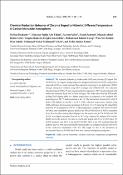Options
Chemical reduction behavior of zirconia doped to nickel at different temperature in carbon monoxide atmosphere
Journal
Indonesian Journal of Chemistry
Date Issued
2020
Author(s)
Dzakaria N.
Abu Tahari M.N.
Salleh F.
Samsuri A.
Azizi M.A.H.
Saharuddin T.S.T.
Yusop M.R.
Isahak W.N.R.W.
Hisham M.W.M.
Yarmo M.A.
DOI
https://doi.org/10.22146/ijc.40891
Abstract
The reduction behavior of nickel oxide (NiO) and zirconia (Zr) doped NiO (Zr/NiO) was investigated using temperature programmed reduction (TPR) using carbon monoxide (CO) as a reductant and then characterized using X-ray diffraction (XRD), nitrogen absorption isotherm using BET technique and FESEM-EDX. The reduction characteristics of NiO to Ni were examined up to temperature 700 °C and continued with isothermal reduction by 40 vol. % CO in nitrogen. The studies show that the TPR profile of doped NiO slightly shifts to a higher temperature as compared to the undoped NiO which begins at 387 °C and maximum at 461 °C. The interaction between ZrO2 with Ni leads to this slightly increase by 21 to 56 °C of the reduction temperature. Analysis using XRD confirmed, the increasing percentage of Zr from 5 to 15% speed up the reducibility of NiO to Ni at temperature 550 °C. At this temperature, undoped NiO and 5% Zr/NiO still show some crystallinity present of NiO, but 15% Zr/NiO shows no NiO in crystalline form. Based on the results of physical properties, the surface area for 5% Zr/NiO and 15% Zr/NiO was slightly increased from 6.6 to 16.7 m2 /g compared to undoped NiO and for FESEM-EDX, the particles size also increased after doped with Zr on to NiO where 5% Zr/NiO particles were 110 ± 5 nm and 15% Zr/NiO 140 ± 2 nm. This confirmed that the addition of Zr to NiO has a remarkable chemical effect on complete reduction NiO to Ni at low reduction temperature (550 °C). This might be due to the formation of intermetallic between Zr/NiO which have new chemical and physical properties.
File(s)
Loading...
Name
Chemical Reduction Behavior of Zirconia Doped to Nickel at Different Temperature in Carbon Monoxide Atmosphere.pdf
Description
Chemical Reduction Behavior of Zirconia Doped to Nickel at Different Temperature in Carbon Monoxide Atmosphere
Size
910.47 KB
Format
Adobe PDF
Checksum
(MD5):45946cdbc1a812f6d853069e5f46b48f